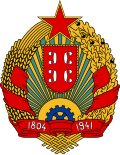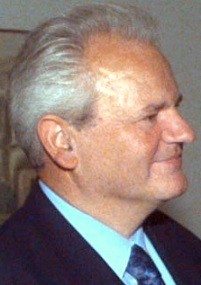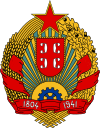
The president of the Socialist Federal Republic of Yugoslavia was the head of state of that country from 14 January 1953 to 4 May 1980. Josip Broz Tito was the only person to occupy the office. Tito was also concurrently President of the League of Communists of Yugoslavia. Tito was eventually declared president for life and with his death in 1980 the office was discontinued and the new office of President of the Presidency of Yugoslavia took its place.
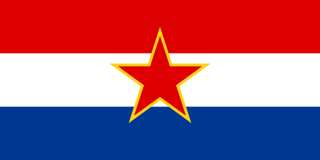
The Socialist Republic of Croatia, commonly abbreviated as SR Croatia and referred to as simply Croatia, was a constituent republic and federated state of the Socialist Federal Republic of Yugoslavia. By its constitution, modern-day Croatia is its direct continuation.
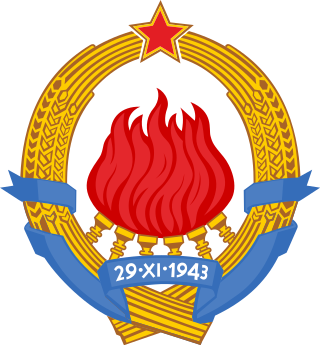
The President of the Federal Executive Council was the head of government of the Socialist Federal Republic of Yugoslavia, from the adoption of the 1963 constitution until the complete breakup of the country in 1992. Most non-Yugoslav sources referred to the post as "Prime Minister."

The Socialist Republic of Bosnia and Herzegovina, commonly referred to as Socialist Bosnia or simply Bosnia, was one of the six constituent federal states forming the Socialist Federal Republic of Yugoslavia. It was a predecessor of the modern-day Bosnia and Herzegovina, existing between 1945 and 1992, under a number of different formal names, including Democratic Bosnia and Herzegovina (1943–1946) and People's Republic of Bosnia and Herzegovina (1946–1963).

The Socialist Republic of Serbia, previously known as the People's Republic of Serbia, was one of the six constituent republics of the Socialist Federal Republic of Yugoslavia in what is now the modern day states of Serbia and the disputed territory of Kosovo. Its formation was initiated in 1941, and achieved in 1944–1946, when it was established as a federated republic within Yugoslavia. In that form, it lasted until the constitutional reforms from 1990 to 1992, when it was reconstituted, as the Republic of Serbia within the Federal Republic of Yugoslavia. It was the largest constituent republic of Yugoslavia, in terms of population and territory. Its capital, Belgrade, was also the federal capital of Yugoslavia.
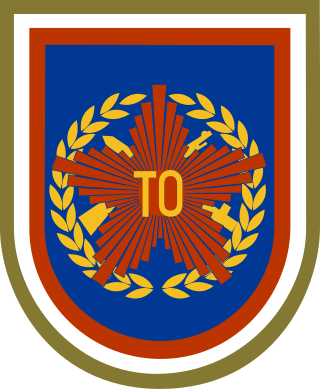
The Territorial Defense was a component of the armed forces of the former Socialist Federal Republic of Yugoslavia that was the primary means of organized armed resistance against an enemy under the Constitution of Yugoslavia. The forces acted as a Home or National Guard which roughly corresponded to a military reserve force or an official governmental paramilitary. Similar to the US National Guard, each of the Yugoslav constituent republics had its own Territorial Defense military formations, to remain separate from the Yugoslav People's Army (JNA), which also maintained its own reserve forces and could take command of Territorial Defense in case of war. This would be done under the command of the Presidency of Yugoslavia as Supreme Commander of Armed Forces through the Minister of Defense, who was the highest military rank that could command both Yugoslav People's Army and Territorial Defense simultaneously under the constitution. While the President of Yugoslavia was in function he was under constitution supreme commander of armed forces, including the JNA and TO, and he could also pass duties as supreme commander to minister of defense.

The Republic of Serbia was a constituent state of the Federal Republic of Yugoslavia between 1992 and 2003 and the State Union of Serbia and Montenegro from 2003 to 2006. With Montenegro's secession from the union with Serbia in June 2006, both became sovereign states in their own right for the first time in nearly 88 years.

The Presidency of the Socialist Federal Republic of Yugoslavia was the collective head of state of the Socialist Federal Republic of Yugoslavia. It was established in 1971 according to amendments to the 1963 Constitution and reorganized by the 1974 Constitution. Up to 1974, the Presidency had 23 members – three from each republic, two from each autonomous province and President Josip Broz Tito. In 1974 the Presidency was reduced to 9 members – one from each republic and autonomous province and, until 1988, President of the League of Communists of Yugoslavia ex officio.

The office of the president of the Presidency of the Socialist Federal Republic of Yugoslavia existed from the death of the President of the Republic Josip Broz Tito on 4 May 1980 until the dissolution of the country by 1992.

The 1946 Yugoslav Constitution, officially titled as the Constitution of the Federal People's Republic of Yugoslavia, was the first constitution of the Federal People's Republic of Yugoslavia. It was adopted by the Constitutional Assembly of Yugoslavia, elected on 11 November 1945. Constitution came into effect at its promulgation, on 31 January 1946.

The 1974 Yugoslav Constitution was the fourth and final constitution of the Socialist Federal Republic of Yugoslavia. It came into effect on 21 February 1974.

The independence of Croatia was a process started with the changes in the political system and the constitutional changes in 1990 that transformed the Socialist Republic of Croatia into the Republic of Croatia, which in turn proclaimed the Christmas Constitution, and held the 1991 Croatian independence referendum.
Dušan Bilandžić was a Croatian historian and politician.

The Socialist Autonomous Province of Vojvodina was one of two autonomous provinces within the Socialist Republic of Serbia, in the former Socialist Federal Republic of Yugoslavia. The province is the direct predecessor to the modern-day Serbian Autonomous Province of Vojvodina.

The office of vice president of the Socialist Federal Republic of Yugoslavia existed from April 1963 to June 1967. It was established by the new Yugoslav Constitution adopted on 7 April 1963. The first to serve in the role was Aleksandar Ranković who assumed office on 30 June 1963. Due to an affair involving wire-tapping of Yugoslav president and general secretary of the League of Communists Josip Broz Tito, Ranković was forced to resign from the Central Committee and from the vice presidency on 1 July 1966. He was subsequently replaced by Koča Popović two weeks later who served out the remainder of Ranković's four-year term. On 26 April 1967 new amendments to the 1963 constitution were approved which disestablished the vice presidency once Ranković and Popović's combined four-year term was up. The office ceased to exist on 30 June 1967.
The Prizren Podgor is a geographical region in Kosovo, stretching from the branches of the Šar Mountains, from Prizren to the village of Dulje on the Crnoljeva mountain. It includes the eastern and northeastern part of the Prizren basin and presents its border region towards the Šar župe of Sirinićka župa and Sredačka župa. It is a sub-region of Metohija. It includes the villages of Skorobišta, Dojnica, Grnčare, Novo Selo, Vrbičane, and the urban settlements of Kurilo and Baždarana, and suburb Ljubižda, of Prizren. It is inhabited by Albanians, Bosniaks, and Serbs.

The office of the vice president of the Presidency of the SFR Yugoslavia existed from the enactment of constitutional amendments establishing the position in 1971 until the dissolution of the country by 1992. A collective presidency existed in Yugoslavia since amendments to the constitution in 1971. The amendments established the roles of President and Vice President within the collective Presidency which would rotate between individual republics and provinces on an annual basis. However, it also defined a separate title of President of the Republic which could be conferred by the Federal Assembly into Josip Broz Tito who would automatically preside over the Presidency as well. Therefore, the launch of the Vice Presidency of the Presidency in 1971 would be the first to carry out a rotation system. Krste Crvenkovski of SR Macedonia was the first to hold the office. The subsequent order after SR Macedonia was SR Bosnia and Herzegovina, SR Slovenia, SR Serbia, SR Croatia, SR Montenegro, SAP Vojvodina, and SAP Kosovo. In 1974 a new Constitution was adopted which reaffirmed the collective federal presidency consisting of representatives of the six republics, the two autonomous provinces within Serbia and the President of the League of Communists.
The Socialist Republic of Croatia, one of the constituent countries of the Socialist Federal Republic of Yugoslavia had gone through a number of phases in its political life, during which its major political characteristics changed - its name, its top level leadership and ultimately its political organization.
